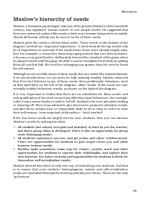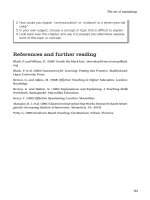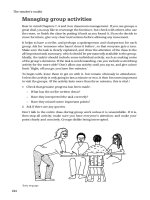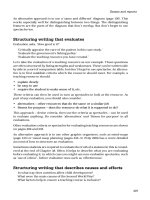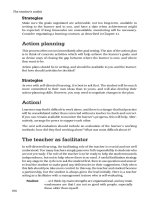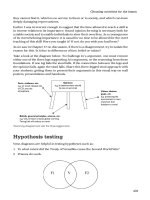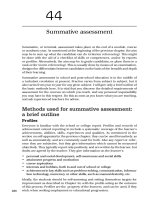Teaching Today A Practical Guide Fourth Edition - part 2 ppsx
Bạn đang xem bản rút gọn của tài liệu. Xem và tải ngay bản đầy đủ của tài liệu tại đây (863.75 KB, 63 trang )
Motivation
55
Maslow’s hierarchy of needs
Maslow, a humanist psychologist, and one of the greatest thinkers of the twentieth
century, has explained ‘human nature’ in one simple model. He suggested that
there are universal, instinct-like needs, which every human being strives to satisfy.
Almost all human activity can be seen in terms of these needs.
Maslow gives the needs a hierarchical order. Those needs at the bottom of the
diagram overleaf are of greatest importance. A need towards the top would only
be of importance to someone if the needs lower down were already largely satis-
fi ed. For example, a researcher observing a gang noticed that one of its members,
who was a very good bowler, deliberately lowered the standard of his game when
he played cricket with his gang. He didn’t want to humiliate his friends by getting
them all out fi rst ball. His need for belonging was greater than his need to boost
his self-esteem.
Although we are not fully aware of these needs, they are rather like mental vitamins;
if we are denied them, we can never be fully mentally healthy. Maslow observed
that if we feel defi cient in any of these needs, then problematic behaviour, such
as that described on the left of the diagram, often results. If the needs are met,
mentally healthy behaviour results, as shown on the right of the diagram.
It is very important to realise that there are no substitutes for these needs, and
only gratifi cation of the need can prevent defi ciency-type behaviours. For example,
when I was a novice teacher I used to ‘tell off ’ students who were attention-seeking
or showing off. Then I was advised to give them more praise for attention to task,
and give them conspicuous or responsible tasks to do in class in order to raise
their self-esteem. I was surprised at this advice – but it worked!
If the two lower needs are largely met for your students, then you can harness
Maslow’s needs by making sure that:
All students feel valued, accepted and included, at least by you the teacher; •
and that a group ethos is developed. There is also an opportunity for group
work (belonging needs).
All students experience success, and get praise and other reinforcement. •
There are opportunities for students to gain respect from you and other
learners (esteem needs).
Routine tasks sometimes make way for choice, creative work and other •
opportunities for students to express their individuality and explore their
own interests. You foster curiosity and opportunities for students to think for
themselves (self-actualisation needs).
Maslow showed that there is only one way of motivating your students. And that
is to ensure that your students’ belongingness, esteem and self-actualisation
needs are nourished through the learning activities you devise. These are the only
‘go buttons’.
P01.indd 55 2/3/09 16:42:16
The learner’s practical and emotional needs
56
Some teachers think motivation is an end in itself, but it benefi ts
learning because it increases attention to the learning task, mental effort
and perseverance in the face of diffi culty. If a classroom is noisy and
distracting, students may fi nd it diffi cult to achieve attention, effort and
perseverance, despite being motivated.
Passive and active learners – learners
taking responsibility for learning
We have seen that learning is not something done to students, but something students
do to themselves. But many students, especially poor learners, seem genuinely to
Needs
The self-actualisation
needs
To make actual what one is
potentially. Personal growth and
development by following one’s
own passsions and interests.
Self-expression, creative action,
need to search for identity and
meaning in life.
The esteem needs
Self-esteem: desire for
achievement, strength and
confidence; adequacy: to be
able to cope by oneself.
Respect: desire for recognition,
reputation, prestige, status and
dignity.
The belongingness and
love needs
The need to give and receive
love and affection.
To belong, to have roots.
The safety needs
Freedom from pain and injury,
security, stability, etc.
The physiological needs
Food, water, air, etc.
If the need is not met
the student feels . . .
If the need is met
the student feels . . .
• restless and bored, with a lack
of zest for life
• life is meaningless, boring and
without purpose
• a tendency to avoid growth
and development
• listless
• fearful of criticism
• fearful of failure and of risks,
e.g. fear of new situations or
learning activities
• fearful, frustrated or angry
toward those who withhold
respect, e.g. a teacher, school or
college
• envy and bitterness
Persistent thwarting leads to
neurotic compensation, e.g.
• chronic showing off,
attention-seeking, arrogance
• shyness and withdrawal
• lonely, rejected and rootless
• strong conformity to group
norms
• dislike or hostility towards
out-groups
Persistent thwarting leads to
neurotic compensation, e.g.
• maladjustment and hostility
• or withdrawal
• anxiety, dread
• fight-and-flight behaviour
• craving for food, water, etc.
• a desire to grow and develop
in the direction of their highe
r
values
• creative, positive and
energetic
• unselfish desire to make a
useful contribution
• curious and open to new
experiences
• a desire to think for
themselves
• a growing sence of identity
• self-confident, content
• self-belief and self-respect
• prepared to take risks and try
something new, e.g. to learn
• cooperative, generous and
kindly
• esteem needs lessen and
higher needs take their
place
• physical security
• safety needs lessen and
higher needs take their
place
• no physiological craving
• these needs die away and
higher needs take their
place
• they can love themselves,
and others
• they can trust friends and
loved ones, and give them
freedom
• these needs lessen and
higher needs take their
place
Maslow’s hierarchy of needs
P01.indd 56 2/3/09 16:42:17
Motivation
57
believe that in order to learn, all they need do is attend classes and carry out the activ-
ities more or less willingly. They then expect that learning will follow automatically.
This ‘passive learner’ approach is described in more detail in the box overleaf.
Look carefully at the box describing active and passive learners. How can we make
our students into ‘active learners’? You must encourage your students to realise
that they must teach themselves with your help (not sit back and expect to pick it up
by osmosis!). It is often worth talking one-to-one with passive learners to encourage
them to take more responsibility for their learning.
You can encourage your students to become active learners by:
discussing the active and passive learning approaches with your students,•
encouraging students to assess their own work and their own learning•
asking students to set themselves targets•
asking searching and puzzling questions as part of your teaching•
avoiding the use of over-controlling ‘recipe’ style worksheets and activities•
getting students to make their own understandings by the use of the question-•
ing teaching method (Chapter 14)
getting students to think for themselves – for example, with group work, •
discussion and the guided discovery method (Chapters 18 and 29).
And perhaps most systematically by:
independent learning, where students take full responsibility for learning •
small sections of the course (Chapter 33)
mastery learning, where students must pass frequent tests or retests •
(Chapter 43)
self-directed learning, where learners take control and responsibility by evalu-•
ating their own performance, and then striving to improve it to meet their
own needs (Chapter 34)
adopting the facilitating approach (Chapter 10).•
Giving the problem to the student
You can encourage students to take responsibility for their learning by giving
the problem to the student. Here is an example:
‘How do you fi nd doing your lab reports, Peter?’
‘Oh. Alright I suppose.’
‘What do you fi nd most diffi cult about them?’
‘The conclusion bit, Miss.’
‘Yes, lots of people fi nd conclusions hard. So what are you going to do to
improve them?’
The technique is fi rst to ask for self-evaluation. If the student does not volun-
teer a problem, then ask a problem-fi nding question, such as, ‘What do you
fi nd most diffi cult?’ Then, when you have found the problem, give it to the
student by asking, ‘What are you going to do about it?’
P01.indd 57 2/3/09 16:42:17
The learner’s practical and emotional needs
58
There are two types of learner:
Active learner Passive learner
Learning is something I do to Learning is something done to me
myself … by experts …
So success or failure depends on So success or failure depends on
me. factors beyond my control:
•
I need to fi nd the right resources.
•
how good the teacher is
•
I need to check my understanding.
•
the resources
•
I need to fi nd my learning problems.
•
my intelligence
•
I need to put these problems right.
•
my talent for the subject
•
In short, I need to take control and
•
etc.
responsibility.
… So if I don’t learn … … So if I don’t learn …
I need to try harder or change my
learning strategy, e.g.: either:
•
try another book
•
the teacher is at fault
•
ask a friend for help
•
the resources are at fault, or,
•
brush up my prior learning. more likely
•
I’m stupid.
Either way, if I take full control and Either way, the only rational course
responsibility, I’m likely to succeed. is to give up!
Mindset: Empowered Mindset: Disempowered
‘I can make a difference.’ ‘It’s all out of my control.’
‘Just try your best.’ ‘I won’t succeed, so I’m giving up.’
Focused on: Focused on:
•
the process: ‘What should I do
•
likely negative outcomes
next?’
•
the impossibility of getting it
•
improvement (rather than perfect
perfection)
•
the negative.
•
the positive (avoids the negative).
adaptive, responsive, self-believing defeatist, fatalistic, despairing
P01.indd 58 2/3/09 16:42:17
Motivation
59
Perhaps it is your attitude and approach that is most crucial. You must see yourself
as a learning facilitator or learning manager, and encourage students to take respon-
sibility for their own learning. This shows respect for the learner, and develops their
self-belief, autonomy and resourcefulness. Conversely, if the teacher always takes
responsibility, this can develop the students’ feelings of dependency and helpless-
ness, and encourage them to avoid the blame for their own poor learning.
Students can be given at least some control over their learning on every course,
as Chapter 41 on course organisation shows. How this ‘facilitating’, ‘self-directed’
approach can be implemented is considered in more detail in Chapters 10, 34
and 41.
Adults will usually feel resentful and alienated if a teacher adopts a command-
and-control approach. Many teenage learners feel the insult just as keenly, and
can become very uncooperative. The teacher has at least as much to gain as the
learner in giving the learner some control.
Professor Carol Dweck has discovered that about half of learners at
every educational level believe their ability is fi xed. The other half
believe ability can be increased by learning. Students who believe it is
fi xed tend to give up in the face of a diffi culty, but those who believe it
can be increased by learning tend to increase their efforts in the face of
a challenge.
See the motivation page of www.geoffpetty.com for more details.
The expectancy–value theory of
motivation
According to the ‘expectancy–value theory’ of motivation, a learner’s motivation
is given by the following formula:
Carl Rogers, in Freedom to Learn, quotes research showing that in only 1 per
cent of their activities are school pupils given some choice.
How much choice, control and freedom (e.g. creative work) are students
usually given in your subject?
To what extent can students meet their self-actualisation needs through the
teaching of your subject?
P01.indd 59 2/3/09 16:42:18
The learner’s practical and emotional needs
60
In this formula, value and expectancy of success are multiplied by each other,
not added together (Feather 1982). This means that if students give their course
an ‘expectancy’ score of zero, then motivation is zero however large the ‘value’
score. Similarly, motivation is zero if they score ‘value’ as zero, however high their
‘expectancy’ score.
How would your students score value and expectations of success? Why not ask
them? Get them to score both value and expectation of success on a scale of zero
to 10, 10 being the maximum score. If you then multiply the value and expectations
marks you will get their motivation expressed as a percentage.
Low ‘value’ score?
Some learners come from families or cultures that do not value education. If no
one in a learner’s family got a job or some other advantage out of education, then
that family may not value education for their children. We need to ‘sell’ the value
of our courses to our students.
Low ‘expectancy’ score?
Talk to students about students in past years who have gone on to be successful, or,
better still, get these past students to come to the class and to talk to them. Stress
that the achievement of these role models was not exceptional when they arrived,
but was due to effort.
Also, make sure that tasks allow students to gain early success by using a mixture
of mastery and developmental tasks for students. Stress that their success came
from their efforts, not innate ability (see Chapters 6 and 43).
You may even be able to arrange for the students to gain an intermediary qualifi ca-
tion very early on in their course. This could be a nationally accepted qualifi cation
such as a fi rst-aid certifi cate, or it could be a school or college certifi cate.
Demotivators
Earlier in the chapter it was pointed out that some factors tend to demotivate
students. Emotional factors such as depression or anxiety due to previous failure
can demotivate. So can environmental and physiological factors such as cold, noise,
hunger, etc. It is also possible to be too motivated! If students are anxious about
examinations, for example, they can overwork and tire themselves, or become so
anxious that their effi ciency falls.
Motivation
V
alue
The value of the
learning to the
learner
Expectancy
The extent to which the
learner
expects
success in
t
he learning
=×
P01.indd 60 2/3/09 16:42:19
Motivation
61
Checklist
Here is a checklist of factors which increase motivation. There is some overlap
between them, but they summarise most of the ideas mentioned in this chapter.
You can use it during lesson planning or as an aid to troubleshooting. Students
will come to your class with some motivation; how you manage in terms of the
factors mentioned below will decide whether you increase or decrease this initial
motivation. Try to get as many of these factors working as possible.
Success
Is the work you set at the right level and speed for your students? ❏
Do you set tasks of varied diffi culty, so that every student can experience ❏
some success, yet more able students are challenged?
If students’ work is not up to standard, do you allow them to rework it until it ❏
is? (Do you then praise or otherwise reinforce their completion of the task?)
Purpose
Do the students understand the personal advantage they will gain from ❏
studying what you are teaching?
Do students appreciate the relevance of what they are studying to the world ❏
of work?
Do you actively ‘sell’ your subject, and the topics you cover within it? ❏
Do you negotiate at least some of the content with students so they learn what ❏
they want to learn? (Chapters 34 and 41)
Enjoyment
Are your lessons varied? ❏
Do your lessons involve plenty of engaging student activity? ❏
Are the student activities you use often fun, e.g. discussion, group work, ❏
games, competitions, challenges?
Do you make use of student relevance and human interest? ❏
Do you excite curiosity by basing your teaching on interesting questions? ❏
Is there an opportunity for students to show creativity or self-expression – for ❏
example, in problem-solving or design activities?
P01.indd 61 2/3/09 16:42:19
The learner’s practical and emotional needs
62
Are you enthusiastic in your teaching? ❏
Are students allowed some choice in what they study? ❏
Do you have a good rapport with your students? ❏
Are there opportunities for students to work collaboratively (social needs)? ❏
Reinforcement
Do your students get frequent reinforcement, e.g. marks, comments, praise? ❏
Does your reinforcement or recognition of success come as quickly as ❏
possible after the student has completed the work?
Are there opportunities for students to satisfy esteem needs (making ❏
presentations, exhibiting work, marks or achieved competences, or other
evidence for success)?
Targets
Are the standards you set seen as worth achieving by your students, as well as ❏
being achievable by them?
Do you test regularly, and set well-managed deadlines for students’ work? ❏
Are the consequences of not learning unpleasant enough to motivate? ❏
Do you set personal targets for learners, and praise them when they are met? ❏
Do you encourage students to take responsibility for their own learning? ❏
Can you encourage your more mature learners to negotiate their own learning ❏
needs, set their own targets, and monitor and assess their own learning?
The fi rst letters of ‘success’, ‘purpose’, ‘enjoyment’, ‘reinforcement’ and ‘targets’
spell ‘SPERT’. If you will excuse the spelling, these factors make your learners ‘spert’
on to greater achievement! Motivation is also affected by the student’s attitude to you,
and to learning; so try to encourage active learning and develop good rapport.
Exercises
Putting the theory into practice
The advice in this chapter expects a great deal of the teacher. It is often hard
to motivate students in practice. Indeed, the consistently negative experience
of education which some young people suffer gives many teachers an impos-
sible brief. However, much can be done to galvanise the majority. Look at the
following teaching situations, and try to formulate a strategy to increase the
motivation of the students concerned. Go through the SPERT factors for each
case, and consider Maslow’s needs and ways of fostering active learning.
P01.indd 62 2/3/09 16:42:19
Motivation
63
1 ‘I need to teach the stages of child development from birth to the early
teens. How can I make that interesting?’
2 ‘I need to teach the role of the planning department in granting planning
applications for new buildings. How can I motivate my students?’
3 ‘I teach some trainee electronic engineers who come to my college for
off-the-job training. I take them for ‘Communication’, and I have been told
to improve their basic writing skills, which are, on the whole, of a very poor
standard. They all say they’ll never get a job when their training scheme is
over, “So what’s the point of me bothering?”
’
4 ‘I teach keep-fi t in an adult education college. Most of the people who
come have shown improvement over the weeks, but Joan, 65 years old,
seems to think that she is too old to make any progress. I often wonder
why she bothers to come, quite frankly. I admit it would take time, but she
is perfectly capable of improving her suppleness and her stamina, both of
which she complains about.’
5 ‘I teach people basic computer skills, mainly at their place of work. The main
problem I have is with older people, who come to the classes with the idea
that computers are impossible to understand for anybody over the age of
50. The depressing thing is that it turns out to be a self-fulfi lling prophecy
– they don’t really try, so they end up being nowhere near as good as the
younger people I teach. Then they say, “I told you so!”
’
Answers
Possible answers for Question 1 on page 54
a Choosing a student in the class who needs to fi ll out a form – for example,
a motorcycle insurance form – and talking over the completion of this form
with the class (human interest).
b Each student could fi ll out a form that is of direct use or interest to him or
her, e.g. an application for a provisional driving licence or an exam applica-
tion form. A dating agency form would also be of interest to most students
(student relevance).
c To encourage curiosity, the teacher could hand out incorrectly fi lled-out
forms with non-obvious errors, and ask the students whether they can see
the errors made (paradox or puzzle).
P01.indd 63 2/3/09 16:42:19
The learner’s practical and emotional needs
64
References and further reading
Argyle, M. (1994) The Psychology of Interpersonal Behaviour, Harmondsworth:
Penguin.
*Dweck, C. S. (2000) Self-Theories: Their Role in Motivation, Personality, and Devel-
opment. Philadelphia: Psychology Press.
Feather, N. (ed.) (1982) Expectations and Actions, Hillsdale, NJ: Erlbaum.
Good, T. L. and Brophy, J. E. (2002) Looking in Classrooms (9th edition), New York:
Allyn & Bacon.
*Holt, J. (1995) How Children Learn (revised edition), Cambridge, MA: Da Capo
Press.
Knowles, M. S. (1975) Self-Directed Learning, Cambridge University Press.
*Maslow, A. H. (1970) Motivation and Personality (3rd edition), New York: Harper
Collins.
Petty, G (2006) Evidence-Based Teaching, Cheltenham: Nelson Thornes.
*Rogers, C. (1994) Freedom to Learn (3rd edition), New York: Merrill.
Any general book on teaching will deal with motivation; Capel et al. (2005) has a
useful section (see the bibliography).
P01.indd 64 2/3/09 16:42:20
65
Let’s try another thought experiment. A teacher training tutor, an experienced
teacher, is going to observe every one of your next 30 lessons. Suppose you have
just taught one of the fi rst lessons to be observed, and you are packing away your
things as the last student leaves the room. It is only the third or fourth lesson you
have ever taught, so naturally you are relieved it is over and anxious to hear how
you did. Assuming you have no reason to distrust the tutor’s judgement, what
would be the effect of the following responses on your confi dence, motivation
and work rate?
The tutor walks straight out of the classroom, saying nothing.1
The tutor praises you effusively, even praising aspects of the lesson that you 2
knew did not go well.
The tutor gives you a detailed analysis of each mistake you made, telling 3
you how to put it right and implying that you should try to improve your
performance.
The tutor praises some aspects of your lesson, but criticises other aspects, 4
and explains what you need to do to improve, fi nishing off by saying that on
the whole you had made a good effort.
You get a mixture of praise and criticism, as in 4, but overall the tutor implies 5
that the lesson was rather mediocre.
If every one of your next lessons was received in the same way – that is, each got
response 1, or each got response 2, etc. then:
A. How would you feel after 30 lessons?
B. How much would you have learned?
C. Is there anything else you would like in the feedback?
Nearly everyone feels quite strongly that they would be most motivated, and learn
fastest, with a response similar in style to 4 above. It is encouraging in that it
recognises success, but outlines ways of achieving a higher standard in the future.
People often mention in answer to C that they would like an opportunity for self-
assessment; hardly anyone asks for their lesson to be graded.
It is most unlikely that the students in your classes will differ from you in their
emotional reactions to praise and criticism. They will hate being ignored; they
will be encouraged by praise; and as long as their successes are recognised and
praised, they will probably fi nd any reasonable, constructive criticism challenging
rather than demotivating. Research reviews confi rm your gut instinct, as we will
see later in Chapter 43 on formative assessment.
6
Praise and criticism
P01.indd 65 2/3/09 16:42:20
The learner’s practical and emotional needs
66
How can we make sure students take our
criticism positively?
Experienced teachers can criticise a student’s work in a way that sounds like advice.
Read the examples below: can you see how the teacher does it?
‘That’s great, your graph has well-chosen scales. Use a pencil, though, then you 1
can rub out any mistakes. All the points look correctly plotted – well done!’
Compare the above with: ‘Don’t use a pen to do graphs.’
‘That’s a great opening sentence, it gets straight to the heart of the issue. Keep 2
it in the future tense, Sheila – can you see where you slipped into the past
tense? … Yes, that’s it, well done.’
Compare with: ‘Don’t mix your tenses up.’
The teacher is mixing praise and criticism, and is giving the criticism in a forward-
looking and positive manner (rather than in a backward-looking and negative one).
For example: ‘Next time check the spelling’, not ‘There are lots of spelling mistakes
here’, and not ‘Next time, don’t make so many spelling mistakes’, which is forward-
looking, but negative. In the second example, the teacher is leading the student to
correct her own mistakes.
In general, learners need:
A medal
Learners need information about what they have done well, and what is good about
it. ‘That’s a great opening sentence, it gets straight to the heart of the issue.’ Learners
need to know what is right about their work, partly to encourage further effort, but
mainly because they often cannot judge this for themselves with certainty.
Medals usually describe positive aspects of the work itself, ‘the product’. However,
they might also include praise for how the work was approached – for example,
the student’s planning and effort, the ‘process’.
A mark, grade or other comparative comment is not a medal but a measurement,
as it does not say what is right or wrong about the work.
A mission
The learner needs information about what needs improving, and how to improve
it. This needs to be forward-looking and positive, so that it sounds more like advice
than criticism and is easier on the ego. Also, it shows how to improve, not just
what is wrong.
Missions close the gap between where students are, and where they are trying to
go. That is, between their attainment to date and the goals.
Missions may include how to do a better job the next time the student does a
similar piece of work. For example, a comment on an essay might say: ‘Try to give
more evidence and illustrations to support your points of view.’
P01.indd 66 2/3/09 16:42:20
67
However, a ‘mission’ might also say how to improve the existing piece of work – for
example, in the case of a draft. ‘Keep it in the future tense, Sheila.’
Clear goals
Medals and missions are related to the goals the student is working towards –
for example, the task – and the criteria used to assess their work. Goals should
be clarifi ed before students attempt the task, of course. Chapter 43 on formative
assessment looks at this in more detail.
If students don’t know where they are going, they are hardly likely to arrive! So
teachers need to clarify the words they use to set tasks.
Similarly, it is good practice to give learners ‘assessment criteria’ which tell them
what they must do for a good mark or grade. But again, students often fi nd these
hard to understand. Come to that, so do many teachers! These need teaching, as
explained in Chapter 43.
Learners have great diffi culty understanding what they are aiming to do.
I remember one student telling me with great authority that ‘describe’,
‘analyse’, ‘criticise’ and ‘evaluate’ all meant the same thing: ‘write
about’.
It may seem odd to include goals here, especially as they are given in advance.
But the medals are the goals the learner has achieved, and the missions are some
goals they still need to work on. For this reason, fi rm ‘goals’ are linked to medals
and missions.
You can’t always include medals, missions and clear goals, especially in a short
piece of verbal feedback. Don’t worry about this, but make sure that over a period
of time, and for any given student, you are not giving medals only, or missions only.
However, do your very best to include medals, missions and goals for all substantial
pieces of work, as explained in Chapter 43.
If you imagine that learning is like rolling a rock up a slope, then learners need
their feedback to be referenced to where they are on the slope, not to where
someone else is. That is, feedback needs to be non-judgemental.
Learners need medals for how far they have rolled their rock, and missions for
how to roll it that bit further. In practice, research has shown that learners get
judgemental feedback, which compares them to each other. Those who do better
than most of their peers tend to get medals, but no missions. Learners who do
worse than most of their peers tend to get missions, but no medals. In each case,
learning is hampered. In some cases, students get neither a medal nor a mission,
just a grade or percentage.
Praise and criticism
P01.indd 67 2/3/09 16:42:20
The learner’s practical and emotional needs
68
‘God himself does not presume to judge a man till the end of his days.
Why then should you or I?’
Ben Jonson
There is an exception to this rule, however. Students with learning diffi culties, and
other learners with very low attainment, are often given medals, but no missions.
This is because teachers are so concerned to preserve learners’ self-esteem with
praise and encouragement, that they fail to show them how to improve, or to set
them a challenging target. This is a grave mistake, as these learners fi nd it hard to
work out a target for themselves.
Some teachers suggest that unless you teach English you should correct
grammar, punctuation, etc. in pencil rather than in red pen. The red pen
should be reserved for subject content.
How can we make sure every student
earns a medal?
It is worth mentioning that even weak students can have their minor successes or
improvements recognised. If weak students persistently get reaction 1 or 3 in the
thought experiment at the beginning of this chapter they will eventually give up – so
would you or I! In the previous chapter, on motivation, I mentioned the ‘learning
engine’, which makes it clear that unless the learner experiences success followed
by some form of reinforcement, learning will not take place.
If praise, self-praise or any other form of reinforcement is to be awarded, the
learner must be at least partly successful in the tasks the teacher has set. Your
opportunity to praise or reinforce learning will be maximised if you:
medal
medal
mission
mission
goals
Medals, missions, goals
P01.indd 68 2/3/09 16:42:20
Praise and criticism
69
Set attainable goals• . Some, but not all, of the learning tasks you set should be
attainable by every student in a matter of minutes, given suffi cient time or
corrected practice. This requires that the tasks be well defi ned, specifi c and
not highly dependent on previous learning. These include lower-order skills
on Bloom’s taxonomy, such as recall, drawing and labelling diagrams, simple
calculations and some simple intellectual skills – for example, explaining three
advantages of terrace farming.
If students are exclusively assessed on their essay-writing or report-writing skills,
then success will elude a substantial majority. Such skills take time to develop, are
highly dependent on previous learning, and involve high-order cognitive skills.
(See mastery and developmental objectives in Chapter 37.)
Break tasks down• . Diffi cult or protracted tasks should be broken down into
manageable steps, which are practised and rewarded separately. Only when
success is achieved on one step is the next step attempted.
Give learning time• . Time should be given for students to practise until mastery
of the learning is achieved. Retests and resubmissions should be accepted so
that the learners are eventually successful, even if they ‘fail’ at fi rst. ‘Relabel
the diagram and show it to me again.’
Recognise partial success• . You should look for something positive in every
piece of work; you will often fi nd something right if you look very carefully!
Recognise the ‘process’ as well as the ‘product’• . Comment positively on how
they worked, as well as on what they did. Recognise effort, the strategy used,
the time invested, thoroughness, asking for help, and so on.
Never restrict praise and recognition• only to those with motivation, aptitude
or fl air.
Two internationally renowned Professors at King’s College London,
Paul Black and Dylan Wiliam, carried out a review of the research
on formative assessment which included how to praise and criticise
students. They concluded that feedback on students’ work probably has
more effect on their achievement than any other single factor. Professor
John Hattie has studied the variables that have the greatest effect on
achievement; he comes to the same conclusion. See www.geoffpetty.com
Positive reinforcement
Medals and missions look at feedback to learners from the point of view of the
information they need to learn well. Behaviourist psychologists look at feedback
from a slightly different point of view. They consider ‘positive reinforcement’,
which is a positive consequence for learning that is likely to increase learning in
the future. (‘Reinforcement’ is not repetition in order to improve learning, as some
people think.)
P01.indd 69 2/3/09 16:42:21
The learner’s practical and emotional needs
70
There are many ways of encouraging a student’s efforts to learn, as the box below
shows; not all of these will work with all learners, of course. Remember that
reinforcement should come as soon as possible, and should be experienced by
every student.
FORMS OF POSITIVE REINFORCEMENT
Extrinsic (from outside the learner)
The teacher:
•
giving attention to the student
•
respecting the student as a person, and showing warmth
•
listening with interest to a student
•
accepting an idea from a student
•
using a student’s work as an exemplar
•
showing interest in the student’s work
•
spending time with the student
•
laughing at the student’s jokes
•
showing high regard for the student
•
writing comments on written work
•
giving smiles, eye contact, thumbs-up sign, etc.
•
ticking in the margin in response to a good point made in an essay
•
exhibiting a student’s work on a noticeboard, for example
•
giving a special privilege, or a ‘merit mark’
Praise from peers, parents and others, including the teacher, of course!
Passing a test or exam.
Something useful to take away from the lesson.
(Chapter 43 on formative assessment will show that grades and marks are
not good positive reinforcers and can have the opposite effect.)
Intrinsic (from within the learner)
Students:
•
studying a topic, or completing a task of interest to them
•
satisfying their own curiosity
•
discovering something for themselves
•
being creative, being in control
•
meeting a challenge (especially one set by themselves)
•
ticking off competences or a task list
•
feeling ‘I can do it! – I got it right!’ or the ‘penny dropping’ feeling
•
achieving personal objectives, or completing a task they set themselves
P01.indd 70 2/3/09 16:42:22
Praise and criticism
71
Mastery learning techniques are excellent for reinforcing learning; they are dealt
with in Chapter 43. Some students will see public praise as a slur on their anti-
establishment image. However, I have yet to meet a student who will not accept
praise privately!
Both reinforcement and criticism can be given informally by non-verbal means – for
example, with facial expression, through tone of voice, by ignoring, by gestures.
Intrinsic reinforcement is a better motivator than extrinsic reinforcement, partly
because it works when the teacher is not there. It is the glow of satisfaction we get
when we feel we have done a job well: ‘I’ve made a widget and it WORKS!’ ‘I can do
FRACTIONS!’ It is also the drive we feel when studying something which excites our
curiosity or when doing something interesting or enjoyable. Creative activity, or any
work where we can show our individuality, generates this intrinsic reinforcement.
Research consistently shows that even experienced teachers think they
give positive reinforcement much more frequently than they actually do;
and that increasing the rates of reinforcement dramatically improves the
atmosphere and work rate in their classes.
From some written work by a 14-year-old boy:
‘When I get a piece of work back and I think it is good, and I get a bad
mark, I feel like frotling the teacher.’
One of the commonest faults of novice and poor teachers is that they are not
positive enough. I’ve seen hundreds in their fi rst few hours of teaching, and I’ve
never seen one praise or recognise achievement too much. Suppose you start in
September with a class of 20 students, whom you see once a week for an hour, and
you make a positive comment once per lesson. At best, some students will have to
wait until June for their turn! If you want every student to get a little recognition
or praise every lesson, then on average you must make a positive comment at least
once every two minutes. During student practice, some teachers can recognise
success more than once a minute. It seems very odd doing this until you get used
to it, but it has a dramatic effect on work rate and atmosphere in the class.
It is common for written comments on students’ work to be almost exclusively
critical. Your students’ mistakes may leap from the page, but don’t let their successes
be taken for granted.
P01.indd 71 2/3/09 16:42:22
The learner’s practical and emotional needs
72
Attainment and effort
Some students achieve a great deal without trying; others achieve very little despite
Herculean efforts. Attainment should, of course, be recorded and acknowledged,
but it is effort to achieve that should be rewarded. If you only praise achievement,
you will discourage weak students and make the able lazy.
‘Never underestimate the pleasure, satisfaction and educational value
which pupils get from satisfactorily completing an action however
simple.’
Michael Marland, The Craft of the Classroom (his emphasis)
President Lincoln wrote a damning letter to General Meade, criticising
him severely for his failure to win a battle in the American Civil War.
Lincoln’s view was that many men had lost their lives because of
Meade’s mistake – certainly more than adequate justifi cation for writing
the letter.
And how did the General respond to the letter? He didn’t, for it was
never sent; it was found in President Lincoln’s papers after his death.
As Dale Carnegie writes in How to Win Friends and Infl uence People,
Lincoln had learned that severe criticism was almost never productive.
P01.indd 72 2/3/09 16:42:23
Praise and criticism
73
But do weak students deserve praise? The answer is an emphatic YES! Indeed, it is
the weaker students who need and deserve it most; they have to battle with work
they fi nd diffi cult and daunting, without the advantage of natural fl air or ability, and
this struggle rarely brings the rewards of work well done. Also, they must suffer
the indignity of watching capable students overtake them with little effort. If some
of our students are attempting to scale Everest without oxygen or crampons, the
least we can do is to nod politely in their direction from time to time!
‘I began by thinking I was marking my students, but then I realised I was
marking my teaching.’
A student teacher
Positive reinforcement improves behaviour too
Ideally, then, during every learning session there should be lots of medals and
missions for every student in your teaching group. This is expecting a great deal,
and not just because of shortage of time. Take snotty detestable little Darren, who
smells of grease or worse, and who regularly emits sacrilegious expletives about
how boring your classes are. When he fi nally stops his habit of kicking Sandra while
staring vacantly out of the window, and actually puts pen to paper, you must step
up to him and offer smiling encouragement. You will not be alone in fi nding this
diffi cult. But if you can’t do it, Darren will never improve; indeed, he will probably
get worse, making your life even more diffi cult.
If you can encourage people like Darren, students of all kinds will come to respect
you, and you will enjoy good relationships with your classes. You will also become a
more effective teacher. But fi rst you must get used to being pleasant and encourag-
ing to people you fear or dislike. Strangely, if you manage this, you may soon fi nd
Darren is less fearsome and detestable than you thought. He may start to respect
you, start to do more work and spend less time ‘playing you up’.
What you will gain from recognising
achievement
Research shows that reinforcement (e.g. medals, praise and other rewards) is one
of the teacher’s most powerful tools. Reinforcement substantially improves the
following, and is usually the single most effective way of improving them:
learning and attainment•
motivation•
behaviour•
concentration in class•
self-belief or self-effi cacy – that is, students’ belief in their own ability to •
improve, to develop and to overcome their own diffi culties
P01.indd 73 2/3/09 16:42:24
The learner’s practical and emotional needs
74
self-esteem•
attitudes to learning and to your subject•
attitudes to the teacher.•
Notice that there are substantial gains for the teacher as well as the student!
You can get students to give themselves feedback with self-, peer and
spoof assessment, as in Chapter 43.
How to praise and reward for maximum effect
There have been many hundreds of research studies on ‘reinforcement’. The
messages from this research show a high level of agreement, but these messages
are not easy to implement! It will take time, thought and practice to become a good
practitioner in this respect. The most effective reinforcement should be:
Frequent!
Try to give every student at least some reinforcement every lesson. Put students
who are a pain or whose progress is slow into ‘intensive care’ – not by beating them
up! This is the teacher’s intensive care, and means recognising their effort and
achievement at least four times an hour, smiling, talking with them in a friendly
manner, etc. Do this for a month, however diffi cult you fi nd it (and you will fi nd it
diffi cult!), and see the results.
Perhaps you doubt whether you can fi nd enough praiseworthy work to give as
many ‘medals’ as I am suggesting? Don’t forget to recognise everyday effort. ‘You’ve
fi nished a question – well done.’ If you reserve praise for conspicuous merit, some
students will never get any, and they will soon be tail-spinning into the vicious circle
I described in the chapter on motivation.
Task-centred not ego-centred
Praise should be earned by, and focused on, the student’s work, not on the
student.
It should be earned for effort, completion of a task, achievement, the skill shown,
an appropriate strategy used, etc.
It should not be given for just being there, or for just listening, say, unless these
are achievements in themselves for that student.
Praise should not be ego-centred, such as ‘You are very good at this’, ‘You are a
very able student’, ‘I’m proud of you’. This is because ego-centred praise
assumes that success is due to personal attributes rather than effective efforts •
to learn
teaches students to interpret diffi culties in terms of a lack of such personal •
attributes.
P01.indd 74 2/3/09 16:42:25
Praise and criticism
75
Student-referenced
Students should be trying to beat their own record, not someone else’s.
Specifi c
You should specify what the praise is for and indicate the value of the accomplish-
ment. In other words, make it a medal rather than just praise. This is easier to
do if it is focused on the task as described above. Saying what the praise is for has
another benefi t of ensuring that the praise is not seen as ‘patronising’:
‘Well done, that’s a good way of solving the problem.’ Or just:
‘That’s a good way of solving that problem.’
‘Correct’ in response to a correct answer to a question.
‘All the commas are in the right place, good.’
‘You are really concentrating well now.’
‘You’ve presented the data very clearly.’
Sincere
You should sound spontaneous, and as if you really mean it (even if you hate the
wretch). Praise should not sound like a ‘refl ex action’ or a habitual phrase just
trotted out for no particular reason. It should not sound to the student as if you
are using praise just as a means to control them.
Not easy, is it?
Some theorists argue that we should abandon praise entirely and
concentrate on self-assessment, and on other medals, in part to increase
intrinsic motivation. This may be particularly true for adult learners.
Exercise
Think back to the thought experiment at the beginning of this chapter. What
would be the effect on your learning if the tutor graded your lesson, and you
found that, compared to your colleagues on your teacher training course,
your grade was almost always
a) in the top quarter of your class?
b) in the bottom quarter of your class?
Read Chapter 43 on formative assessment to see if research confi rms your
view!
P01.indd 75 2/3/09 16:42:25
The learner’s practical and emotional needs
76
Checklist
Criticism
Do you accept the student’s standard, however high or low, and set about ❏
encouraging and improving it in stages, by medals, missions and other
positive reinforcement?
Is your criticism forward-looking and positive, and do you mix it with praise? ❏
Do you allow resubmission of unsatisfactory work? ❏
Do you ask your students to evaluate their own work and set themselves ❏
targets?
Do you set the most able students the most challenging targets? ❏
Are your students kept informed of how their attainment compares with the ❏
needs of the course?
Do you break tasks down into manageable steps, and reward their ❏
achievement?
Do students set themselves targets for improvement? ❏
Exercise
Work out your own policy on medals, missions and other forms of positive
reinforcement.
How will you make sure that the points in the summary above and the check-
list will be achieved in practice? You could do this after reading Chapter 43.
Do weak students deserve praise?
P01.indd 76 2/3/09 16:42:26
Praise and criticism
77
Praise
Do you set each student achievable goals so they all experience some success? ❏
Do you always acknowledge positively a correct answer given to a verbal ❏
question?
Are you able to give plenty of medals? For example, can you praise effort, ❏
progress and the completion of routine tasks?
Does every student receive some reinforcement and some constructive ❏
criticism?
References and further reading
See also the references for Chapter 43.
*Dweck, C. S. (2000) Self-Theories: Their Role in Motivation, Personality, and Devel-
opment. Philadelphia: Psychology Press.
*Good, T. L. and Brophy, J. E. (2002) Looking in Classrooms (9th edition), New York:
Allyn & Bacon.
*Holt, J. (1967, revised 1983) How Children Learn, London: Penguin.
Wright, C. J. and Nuthall, G. (1970) ‘The relationship between teacher behaviour
and pupil achievement’, American Educational Research Journal, 7: 477–91.
www.nwrel.org/scpd/sirs/2/cu3.html has a good research review on rein-
forcement.
Exercise
1 Ask a colleague to observe one of your lessons, and to count the number
of times you reinforce a student. Ask them also to count the number of
students who receive no reinforcement.
2 If all the students in a group are having trouble with something, many
teachers would blame the group. Others would blame their own teaching.
What do you think?
3 What are the relative values of ticks, marks and comments on written
work?
4 What are your feelings about having your own work marked? Do you
remember your feelings about being marked at school?
5 Can you explain the importance of both extrinsic and intrinsic reinforcement
by reference to Maslow’s ideas mentioned in the last chapter?
P01.indd 77 2/3/09 16:42:26
78
First impressions
When you go for an interview, you put on your best clothes. Employers are affected
by fi rst impressions, but so are you as a teacher. Social psychologists believe that
when we meet someone for the fi rst time, we select information from what we
perceive, and process it in an attempt to develop a rapid characterisation of that
person. We do this because we want to know how to behave towards the person,
and how we can expect them to behave towards us. It would of course be fairer to
suspend judgement, but few of us manage this in practice.
Individuals differ in the information they use to form this initial characterisation.
Typically, impressions are obtained from factors such as dress, hairstyle, facial
expressions, posture, gestures, age, ethnic origins and gender, as well as what the
person says or how they say it. Teachers may also be affected by a student’s hand-
writing, friendship group, previous attainment, reputation, and so on.
Once these characterisations are formed, they are used to make judgements about
the thoughts, feelings, attitudes, goals and traits of the person concerned. The
table on the next page shows a teacher’s initial characterisations of two students,
Samantha and Kevin, both in the same class.
These initial characterisations will of course infl uence the teacher’s behaviour
towards Kevin and Samantha.
7
The teacher–learner
relationship and equal
opportunities
Here are the test marks. All those with neat handwriting and new blazers: A. Everyone else: B. Except
scruffy, gum-chewing personal stereo users: fail.
P01.indd 78 2/3/09 16:42:26
The teacher–learner relationship and equal opportunities
79
Name Teacher notices: Teacher’s personality theory
leads him/her to surmise:
Samantha She is quiet, polite, well-
dressed, attractive and
middle-class.
She will be interested in study,
intelligent, hard-working and
pleasant.
Kevin He is large, ungainly,
unfashionably dressed,
communicative, with a strong
rural accent and a loud voice.
He’s ‘thick’, uninterested in
study; working-class; likely
to become a farm labourer;
could be a troublemaker.
‘It is perception not reality which is crucial in determining behaviour.’
Carl Rogers
First impressions stick
The problem with our fi rst impressions, or ‘initial characterisations’, is that
they are resistant to change: rationalisations preserve them from contradictory
evidence. For example, Samantha in the table above has been seen as a commit-
ted student. Suppose she starts to smile in a lesson. The teacher might then think,
‘She’s enjoying my lesson. I knew she would be a good student.’ If Kevin starts
to smile, however, the teacher is likely to think, ‘What mischief is he up to?’ The
same evidence is used to draw opposite conclusions, each confi rming the initial
characterisation.
If Samantha turns in a poor piece of work – well, ‘She must be tired.’ If Kevin hands
in a good piece: ‘Who did he copy?’ If Samantha is short-tempered: ‘Poor thing, she
must be upset about something.’ If Kevin is polite and pleasant: ‘Why is he trying
to butter me up?’ I exaggerate for effect, but it is dangerous to believe one is above
such rationalisations; I am certainly aware of having fallen prey to them.
Darwin concluded that he needed to keep a notebook and pencil with
him at all times, as he found that he remembered evidence in favour
of his theories, but quickly forgot evidence against them! We too tend to
have selective memories about our students’ work and behaviour.
Both students will become aware of the teacher’s appraisal of them. Samantha will
get eye contact, smiles and friendliness – and Kevin will notice their absence. This,
in turn, will affect the students’ behaviour; they are both likely to behave more like
the teacher’s characterisations of them.
P01.indd 79 2/3/09 16:42:26

